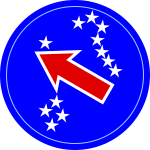Loading AI tools
Army service component command of the United States Army From Wikipedia, the free encyclopedia
The United States Army Pacific (USARPAC) is an Army Service Component Command which serves as the Army service component for United States Indo-Pacific Command.[1] It may also serve as a Joint Task Force headquarters. The command has forces in Alaska, Hawaii, Japan, and South Korea. It also performs missions in Southeast Asia, in the countries stretching from the Philippines all the way to Bangladesh and India. United States Forces Korea (USFK) has had operational command and control of US Forces in Korea since January 2012, and USARPAC headquarters oversees the manning, training, and equipping of US Army forces assigned to USFK.[2]
| United States Army Pacific | |
|---|---|
 USARPAC shoulder sleeve insignia | |
| Active | 1898–present |
| Country | |
| Branch | |
| Type | Army Service Component Command/Theater Army |
| Role | Command (military formation) |
| Part of | |
| Garrison/HQ | Fort Shafter, Hawaii |
| Motto(s) | One Team |
| Colors | White and red |
| Decorations | Presidential Unit Citation x 2 Superior Unit Award Philippine Republic Presidential Unit Citation |
| Campaigns | World War II |
| Website | U.S. Army Pacific |
| Commanders | |
| Commanding General | |
| Deputy Commanding General | |
| Deputy Commanding General (AUS) | |
| Senior Enlisted Leader | |
| Insignia | |
| Distinctive insignia |  |
| Abbreviation | USARPAC |
However, subordinate units of this command sometimes perform humanitarian missions in places such as Haiti, Cuba, and the Middle East.
USARPAC traces its lineage back to 1898 when the United States became a major power in the Pacific. In 1921 Fort Shafter became the headquarters for the Hawaiian Department. When the United States entered World War II, the Hawaiian Department became subordinate to the Commander-in-Chief, Pacific Ocean Areas.
Throughout its history the command was designated:
During the Korean War, USARPAC provided combat forces, training, and logistics.
During the Vietnam War, the command provided the same support to United States Army Vietnam. After the war the Army cut its presence in the region as there was no longer a need for such a large number of combat forces in the Pacific. Subsequently, USARPAC was eliminated as a component command and Army forces in Korea and Japan became separate major commands. In Hawaii, USARPAC headquarters was superseded by US Army Support Command Hawaii (USASCH) and a Department of the Army field operating agency, US Army CINCPAC Support Group.
In 1979 the Army established US Army Western Command (WESTCOM) as a major command and the Army component of US Pacific Command. WESTCOM took command of Army forces in Hawaii. In 1989 it added United States Army Alaska and in 1990 United States Army, Japan. In 1990 WESTCOM was renamed USARPAC. USARPAC has sent forces on multiple humanitarian missions, disaster relief, and defense support of civil authorities.
In October 2000 the headquarters reorganized as a multi-component Army service component command.
Since 9/11, the command plays a major role in the homeland defense of the United States. The command has also sent soldiers in support of the Global War on Terrorism to fill operational gaps.
The command insignia was designed in 1944. It depicts the axis of advance of U.S. forces across the pacific.

Former units include the U.S. Army Chemical Activity, Pacific, at Johnston Atoll, which traced some of its history to the 267th Chemical Company and the Project 112 biological warfare defense experiments. This became the Johnston Atoll Chemical Agent Disposal System, which was finally deactivated in 2001.
Seamless Wikipedia browsing. On steroids.
Every time you click a link to Wikipedia, Wiktionary or Wikiquote in your browser's search results, it will show the modern Wikiwand interface.
Wikiwand extension is a five stars, simple, with minimum permission required to keep your browsing private, safe and transparent.